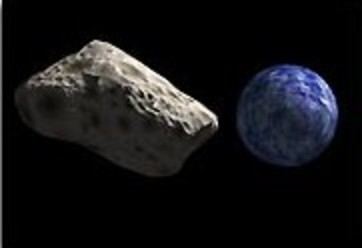Discovery date 2000-09-29 Observation arc 507 days (1.39 yr) Inclination 0.1114092° Discoverer David J. Tholen Asteroid group Apollo asteroid | Discovered 29 September 2000 Argument of perihelion 275.16302° Discovery site Mauna Kea Observatories | |
 | ||
Discovered by D. J. Tholen, and R. J. Whiteley Aphelion 1.04290676 AU (156.016631 Gm) Semi-major axis 0.97752227 AU (146.235250 Gm) Similar David J Tholen discoveries, Other celestial objects | ||
2000 sg344
2000 SG344 (also written 2000 SG344) is a small Aten asteroid discovered in 2000. It is estimated to have a diameter of 37 meters (twice that of the Chelyabinsk meteor) and a mass of 7.1×107 kg (71,000 tonnes).
Contents
Because of its very Earth-like orbit and because it would have been near the Earth in 1971 (coinciding with the Apollo program), there was speculation that 2000 SG344 might not be an asteroid but a man-made object such as an S-IVB booster stage from a Saturn V rocket (cf. J002E3, the S-IVB booster of Apollo 12 which was mistaken for an asteroid.)
Possible impacts with Earth
Until December 2004, it was considered to have the highest (though still very low) likelihood of any near-Earth object to impact Earth in the next 100 years. It is ranked a zero on the Torino scale of impact risk because of its small size (the scale is 0–10) and is listed on Sentry Risk Table. It was briefly surpassed in December 2004 by 99942 Apophis (which at the time was known only by its provisional designation 2004 MN4). The smaller asteroids 2006 JY26 and 2010 RF12 have a greater chance of impacting Earth.
Based on 31 observations of 2000 SG344 made from May 1999 to October 2000, there is about a 1 in 417 chance that it will collide with Earth between 2069 and 2113. Assuming the object is a rocky asteroid, the impact energy released would be an estimated 1.1 megatons of TNT, which would create an impact crater approximately 100 feet (30 m) wide assuming it does not explode in the atmosphere.
Planned NASA mission
NASA is considering it as a possible target for a manned mission (Exploration Mission 2) using the Orion spacecraft, prior to a projected 2030 push to Mars. 2000 SG344 will be observable in April 2028 at an apparent magnitude of 19.
